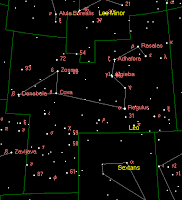
For the last of our late winter early spring constellations, let’s take a look at Leo, the Lion.
Leo is one of the constellations that actually looks reasonably like what it’s supposed to represent.
The brightest star of this constellation, alpha Leo, is called Regulus (meaning: the little king), it’s a blue-white star and when viewed with binoculars or small telescopes a fainter companion star of can be seen.
At the tip of the lion's tail the blue-white star beta Leo, or Denebola, viewed through a telescope beta Leo seems to have an orange companion, but actually the two stars are far away from each other – it is an “optical” double as opposed to a real double star system.
Another excellent double is the binary gamma Leo, or Algieba (the lion's mane), this pair, consists of a orange-red giant and a yellow giant, a small telescope is sufficient to split gamma Leo into the single stars.
Leo contains many bright galaxies, of which Messier 65, Messier 66, Messier 95, Messier 96, Messier 105, and NGC3628 are the most famous.
Have an enjoyable lion hunting safari!!
Image credit John Walker








 For the first of our late winter early spring constellations let’s take a look at Gemini. The constellation is dominated by Castor and Pollux, two bright stars that appear relatively close together, encouraging the mythological link between the constellation and twin-ship. The twin to the right is Castor, whose brightest star is α Geminorum (more commonly called Castor) and the twin to the left is Pollux, whose brightest star is β Geminorum (more commonly called Pollux); the other stars can be visualized as two parallel lines descending from the two main stars, making it look like two figures. At present a further “bright star” can be found to the left of Castor & Pollux, the star is in fact the planet Mars.
For the first of our late winter early spring constellations let’s take a look at Gemini. The constellation is dominated by Castor and Pollux, two bright stars that appear relatively close together, encouraging the mythological link between the constellation and twin-ship. The twin to the right is Castor, whose brightest star is α Geminorum (more commonly called Castor) and the twin to the left is Pollux, whose brightest star is β Geminorum (more commonly called Pollux); the other stars can be visualized as two parallel lines descending from the two main stars, making it look like two figures. At present a further “bright star” can be found to the left of Castor & Pollux, the star is in fact the planet Mars.















